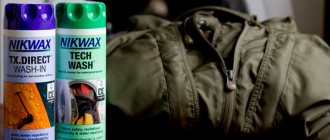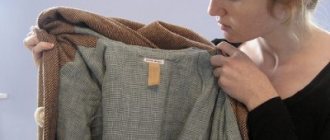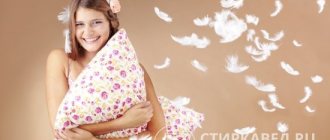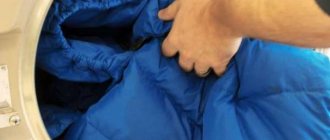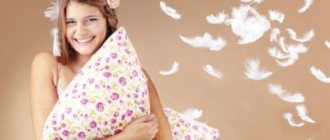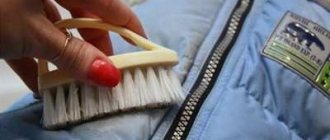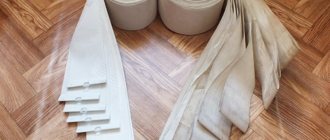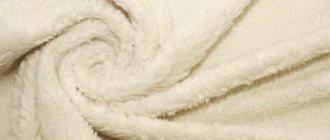Manufacturers do not recommend washing coats in SMA; the experience of many owners suggests the opposite. So is it possible to wash a coat in a washing machine? If you follow all the recommendations, washing your coat in a washing machine is still possible. So that you don’t have any problems, let’s try to figure it out: what mode to choose, what tool to use. You will save time and money on going to the dry cleaner. Let's get started.
How to prepare a coat for machine washing
First you need to generally understand whether the item can be washed. A tag with special icons will help here, indicating how to clean the product: different fabrics are washed in different ways. Crossed out images of a washing machine or basin prohibit washing. Suitable for dry cleaning only.
If washing is allowed, then you need to prepare for the process. Before loading into the machine, you must follow these rules:
- empty your pockets;
- buttons, locks, buttons to fasten;
- Remove metal parts and decorations (otherwise rust may appear);
- unfasten the fur, otherwise it will fall off;
- Turn the coat inside out.
Preparation
First, you should study what fabric the coat is made of, what properties it has and whether it can withstand high temperatures. It is best to consult the manufacturer if it is listed on the label. It happens that the tag is located on the side seam, and it only contains storage instructions. Perhaps there are inscriptions in Chinese that are impossible to enter even into an automatic translator - you will have to guess every character on the keyboard so that it matches what is written. And in case there are no tags, our recommendations and video are in this article
will help you understand the sequence of actions.
So, coats are most often made from the following fabrics, which require washing in certain conditions. Let's look at this issue in more detail below and find out whether it is possible to wash a coat in an automatic machine. There are also some things to keep in mind:
Composition of the coat
Thickness
Color
Lining
Availability of sizing
Presence of fur
One way or another, if cleaning the fabric in a machine is prohibited, you will have to use manual cleaning.
Features of washing autumn and winter coats
There are several recommendations on how to wash a coat in a washing machine if it is a demi-season or winter coat. Autumn and spring coats are light, with a minimum number of layers, not so dense, made of soft fabrics. A coat for cold weather has three layers: a dense top layer that protects from the cold, insulation and a lining.
Demi-season coat
Natural wool, drape, cashmere, cotton require more attention. When washing them, be sure to follow a delicate cycle without spinning and a low temperature.
Important! It is best to dry woolen items on hangers. Before it dries, it needs to be ironed with a slightly warm iron. Then hang it on the hanger again, without straightening it, without stretching it, and it is better in a room where there is air “walking” or on the street. The main thing is not in direct sun, maybe in a loggia, for example. This is necessary to avoid an unpleasant damp smell.
Things made of polyester are not so capricious. They wash easily, dry quickly, and do not lose their shape. True, it also has its own characteristics. If the water is too hot, wrinkles will form that are difficult to get rid of. The best temperature is 40 degrees. Dry the polyester coat on hangers.
Winter coat
A winter coat contains natural insulation (down, feather) or artificial (sintepon, holofiber). The table clearly shows what to wash and how:
| Material | Washing type | Washing mode | Temperature | Facilities | Drying |
| Sintepon, holofiber | Machine | "Synthetics" "Manual" "Delicate" | 30-40 degrees | Liquid products, gels | First horizontally, then on hangers |
| Feather | Machine | "Delicate" | Less than 30 degrees | Special liquid detergents for washing down jackets | Dry in a ventilated area, away from other things. |
It must be remembered that during washing the insulation may clump into clumps. Plastic balls with spikes will save you from such trouble, and some even prefer tennis balls. They are simply placed in the drum of the machine. Three balls are enough. They “break” the filler and prevent it from clumping.
Advice. The down jacket will please its owner with a refreshed look if first, before the main wash, you simply rinse it twice without powder in the machine (this way you can remove excess dust from the down), and after washing, rinse it three more times (this is how the detergent will be washed out best).
We recommend:
How to wash a leather skirt
When drying coats that contain insulation, there are some peculiarities. First you need to lay the wet product horizontally, and when the coat dries a little, you can hang it on hangers. The explanation is simple: if you immediately hang a coat with filling on a hanger, then the weight will cause the filling to fall down.
Important! When shaping the washed coat, it is necessary to straighten the lining well so that it does not peek out from under the outer fabric in the area of the hem and cuff.
By the way, the down jacket should also be dried correctly. There must be air circulation in the room where it is dried. Such clothes should not be dried close to other things. For quick drying, a place close to the radiator is suitable (but, of course, you can’t hang it on it!).
Preparatory stage
There are a number of basic recommendations on how to properly wash coats made from various fabrics. First, begin preparing the product for the cleaning procedure:
- Fur parts (cuffs and collar and hood with fur trim) are removed. If the manufacturers have not provided for this, you will have to carefully rip it off. Faux fur inserts do not need to be removed.
- Decorative elements and large metal parts must be removed so that the fabric is not damaged in the process.
- For delicate natural fabrics, you need to choose a special detergent, which is intended not only for washing, but also for softening and antistatic.
- It is necessary to carefully inspect the pockets. You should take all of them out.
- If there are specific stains (coffee, tea, grass, etc.), they must be treated with anti-stain products immediately before washing.
Which fabrics should not be machine washed?
Cashmere and drape do not like machine washing. Cashmere is very vulnerable to damage: it shrinks and rolls. And the drape may have glued parts that will suffer from moisture.
You can first try to clean visible dirt with a sponge. To do this, a mild detergent of low concentration is diluted in cool water and whipped into foam. Just dip a sponge into this foam and clean it, and remove the foam residues with a clean, damp sponge.
It is permissible to wash a “capricious” coat completely. The main thing is not to allow any rough mechanical actions with your hands, just moisten and “squeeze” the fabric a little in warm water with diluted wool detergent. Rinse in cold water.
Cashmere items are shown to be dried horizontally. It is carefully laid out without stretching, preferably on a towel. Then you need to periodically check how it dries. When it's half wet, it's time to hang it on your hanger.
A drape coat can be dried directly on a hanger.
| Material | Washing type | Washing mode (for washing machine) | Temperature | Facilities | Drying |
| Wool | Machine | "Delicate" | Less than 30 degrees | Liquid products | First iron with an iron at minimum temperature, then hang on hangers in a ventilated area. |
| Cashmere, drape | Manual local | Easy to rub with a sponge soaked in foam detergent | Cool water | Mild detergent, baby shampoo will do | On hangers |
| Cashmere | Manual, fully immersed in water (if there are no adhesive parts) | Only lightly squeeze the fabric, do not rub or twist | Slightly warm water | Liquid hair product | On a horizontal surface on a towel, then on a hanger |
| Drape | 30 degrees | On hangers |
Useful tips
Recommendations for caring for a coat will allow you to maintain its attractive appearance for as long as possible and wash it without damaging or spoiling it:
- The greater the amount of natural fibers present in the material from which the coat is made, the higher the likelihood that after washing it will shrink, become covered with pills or become deformed.
- Select a detergent according to the type of material and its color.
- To wash a cashmere or wool coat, use a special gel product - WELLERY DELICATE Wool. It perfectly removes stains in cool water, refreshes, retains the shape of the product and its color, and is easy to rinse.
- Don't neglect preparing your coat for washing. Remove the contents from the pockets, turn them inside out, fasten all buttons, rivets, and zippers.
- Glued elements may simply fall off upon contact with a detergent solution; for this reason, when washing the product, try not to wet these places.
In some cases, manufacturers dye fabric using dyes that are not of very high quality, so when washed, the color is removed along with the dirt. Before putting your coat in the machine, test the solution on an inconspicuous area of the garment or, better yet, on a spare piece that usually comes with the coat.
What to do if you can’t wash your coat
How to wash a coat at home if the label says “do not wash” or “dry clean only.” There's a little secret here. The manufacturer states that the fabric requires the most careful approach.
Additional Information. There are not many materials that do not tolerate water at all. These are leather, suede and fur. You cannot wash a coat with non-removable decorating parts or trim.
If washing in water is contraindicated, then you need to wash it as dry as possible.
It's better to remove the dust first. You can walk over a drape coat with a coarse brush in the direction of the pile or vacuum it with a brush attachment. Modern technology has a mode for cleaning curtains.
Cashmere is a soft and delicate material; to remove dust from such a coat, wipe it with a damp cloth.
A little about detergents
Before you start washing, you need to look at the label. It indicates which substances contact should be avoided. Only after this can you go to the store and buy special cleaning products.
In large stores you can find cleaning products for every type of fabric. But if there is no specific product, then you can choose a liquid detergent for delicate washing and check its composition. If it does not contain substances that can harm the coat, then such a product is considered acceptable.
It is also worth looking for products for woolen items that require careful care. Here it is better to spend your time and find a special product that washes the material as carefully as possible.
In addition, you should pay attention to whether the cleaner is a universal one or whether it is intended for a specific color scheme. If the second option, then it can only be used with recommended fabric shades. On other colors, the detergent may leave streaks or change the original color.

